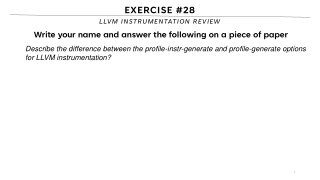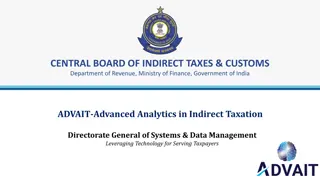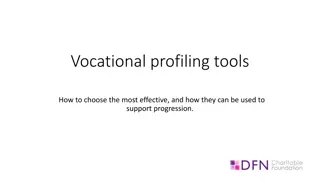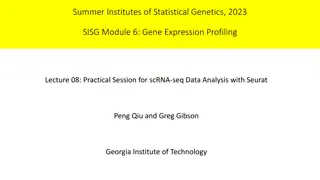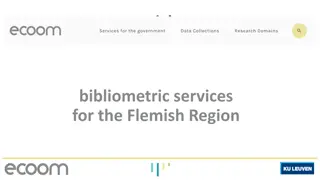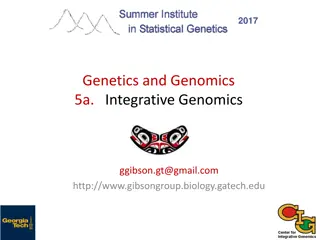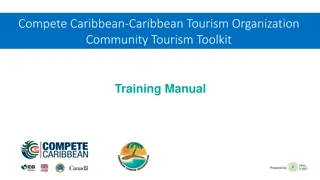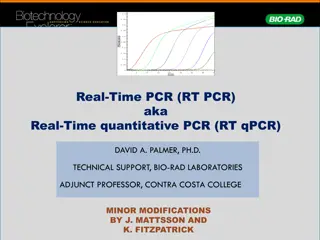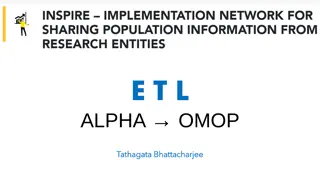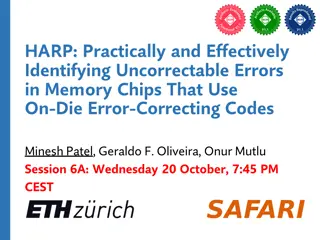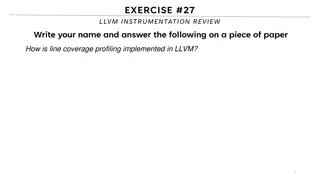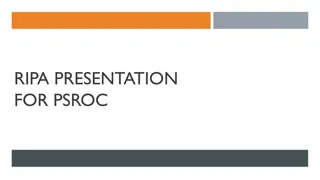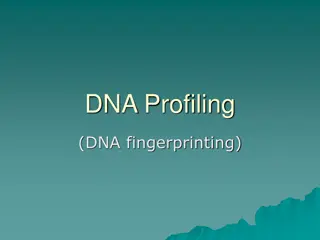
Performance Analysis Tools and Methods for System Optimization
Explore the importance of visualizing and understanding performance in big systems using tools like profilers and analysis methods. Learn how const, constexpr, and templates play a role in performance analysis while balancing elegance and efficiency. Discover the balance between tools and visual thinking to identify and resolve bottlenecks for optimal system performance.
Download Presentation

Please find below an Image/Link to download the presentation.
The content on the website is provided AS IS for your information and personal use only. It may not be sold, licensed, or shared on other websites without obtaining consent from the author. If you encounter any issues during the download, it is possible that the publisher has removed the file from their server.
You are allowed to download the files provided on this website for personal or commercial use, subject to the condition that they are used lawfully. All files are the property of their respective owners.
The content on the website is provided AS IS for your information and personal use only. It may not be sold, licensed, or shared on other websites without obtaining consent from the author.
E N D
Presentation Transcript
Professor Ken Birman CS4414 Lecture 12 PROFILERS CORNELL CS4414 - SPRING 2023 1
OUR CHALLENGE TODAY Can we pull these different threads together? We care a great deal about performance but also elegance (and correctness, security, algorithmic efficiency) We are working with big systems that use big libraries The theme, throughout, centers on taking control of things: the hardware, Linux, the C++ compiler, your own code Can we visualize how all these elements interplay and use our vision to identify unexpected bottlenecks? CORNELL CS4414 - SPRING 2023 2
AN UNDERSTANDING OF CONST, CONSTEXPR AND TEMPLATES CLARIFIES PERFORMANCE ANALYSIS Knowing how to visualize a program lets us assess performance: We need to learn how gprof and other profiling tools work, but then can use them to diagnose performance problems. With a clear mental image of how things should work, we can identify surprising overheads that may lead to insights about root causes of slow performance. CORNELL CS4414 - SPRING 2023 3
TOOLS VERSUS VISUAL THINKING A tool is used to measure something. You learn some number. The image in your mind shapes the questions you ask the measurements you need. If you cannot visualize how something is working, you won t be effective at evaluating performance. But sometimes you have is it A or B? questions. Tools can help! CORNELL CS4414 - SPRING 2023 4
IDEA MAP FOR TODAY Use performance analysis tools and methods to confirm your expectations or to discover surprises What determines performance? 90% - 10% rule Aim for the biggest wins with the smallest changes to the code Visualize the expected behavior of your program! Should we do extensive hand-optimization, or can we shape the system to achieve our goals through elegant, higher-level methods? CORNELL CS4414 - SPRING 2023 5
RULES OF THUMB Simple suggestions often work well even if overly vague Performance analysis is like measuring with your thumb: more like an art than a science! CORNELL CS4414 - SPRING 2023 6
RULES OF THUMB Start by trying to understand the big picture! There is always some big thing that dominates performance. Your job is simply to identify it. And this should be easy because whatever it is, the program spends a lot of time on it! CORNELL CS4414 - SPRING 2023 7
TODAY: ARE THERE SIMPLE RULES FOR PERFORMANCE ANALYSIS? Suppose you are given a big program written by a team. It has 25,000 lines of really hard to understand code. Your job: it runs for 10 secs, and your boss thinks this is too slow. How much speedup is possible? Could you get a 10x or better speedup? How will you approach this? CORNELL CS4414 - SPRING 2023 8
IDEA OF A SIMPLE RULE: HOW DO WE GET CODE TO COMPILE? Always fix the first line the compiler complains about! A single issue can cause dozens or hundreds of error messages, so each compilation issue you fix might clear many more. CORNELL CS4414 - SPRING 2023 9
IDEA OF A SIMPLE RULE: HOW DO WE DEBUG OUR CODE? Fix the very first thing that goes wrong in any execution. Even if the first issue is obscure , fixing it will shed light on any systematic mistakes you might be making. It will also get rid of secondary effects. Unit test all your components, one method a time. Issues with basic components can confuse you: you might think the bug is in the code using that method, not in the method itself. CORNELL CS4414 - SPRING 2023 10
SIMPLE RULE FOR PERFORMANCE ANALYSIS Speed up the thing the program is doing the most on the critical path (even if it is just waiting). By most , think of elapsed wall-clock time Ignore the rest. Why mess with stuff that works? CORNELL CS4414 - SPRING 2023 11
25,000 LINES OF CODE Probably 250,000 machine instructions. Your computer runs at about 1 billion instructions per second. So, each CPU can execute 10B instructions in 10s. 10B / 250,000 = 40,000 Was every line of the program really executed 40,000 times? CORNELL CS4414 - SPRING 2023 12
TO CONSUME 10 SECONDS OF CPU TIME The program must be (1) in some form of loop, or (2) running a recursive algorithm that has high complexity. (3) Stuck, waiting Unless the entire program is a massive loop, it is far more likely that just part of the program is responsible. A great many studies confirm this intuition! CORNELL CS4414 - SPRING 2023 13
EVERY PROGRAM LOOKS SIMILAR WHEN VIEWED FROM A MILE UP Most programs have a lot of non-executing code, and a lot of code used just when starting up, or just when printing output. A program generally spends 90 to 99% of its running time in just 10% or less of the code, and often much less. CORNELL CS4414 - SPRING 2023 14
BUT FIRST YOU NEED TO KNOW IF THE PROGRAM IS SPENDING A LOT OF WAITING Linux has many tools that can help. With top you can watch when the program is executing. Is it keeping one or more cores busy? If a process is fully busy on 8 cores, it shows as 800% loaded CORNELL CS4414 - SPRING 2023 15
IOSTAT, VMSTAT If a program runs for a long time but has low CPU utilization, it must be waiting for the Linux kernel to do something . Iostat monitors I/O activity and can help you understand if your application is overwhelming the file system. Vmstat monitors paging. High paging rates will slow you down CORNELL CS4414 - SPRING 2023 16
EXOTIC TOOLS Mpstat: Multi-processor statistics. Extremely useful for programs that are multi-threaded. Try mpstat P ALL Sar: This command is often used to create periodic reports that it will mail to the system administrator. For more automated uses. CORNELL CS4414 - SPRING 2023 17
EXOTIC TOOLS CoreFreq: An Intel tool for collecting information about the cores on a NUMA machine, including cache stalls, instruction prefetch stalls, etc. Requires a special setup first, to disable a few Linux features that might otherwise confuse the output. Htop: Similar to top, but some people prefer the output format, and it has a few options top lacks. CORNELL CS4414 - SPRING 2023 18
# perf stat -p 2087 EXOTIC TOOLS Perf: A bit like CoreFreq, but tracks a wide variety of process behaviors and reports on them. You can ask it to focus on a particular process this way: perf stat -p 1234 // replace 1234 with the process-id CORNELL CS4414 - SPRING 2023 19
YOUR TASK? First, understand if the process is genuinely busy. If it is, you need to find that core portion that loops so heavily. If the slow path is idle then you can focus on what the code is waiting for, and why it waits for so long. Could be system calls to the kernel Could be locks that for some reason aren t released quickly CORNELL CS4414 - SPRING 2023 20
GPROF If you compile your program with the pg flag, and if it exits normally (main returns), a profile file will be written. Then when you execute gprof myprog, grprof prints pages of output that can narrow the exact spot down in your code that spends so much time looping! CORNELL CS4414 - SPRING 2023 21
HOW IT WORKS There are two aspects Linux kernel helps by using timers to build a histogram of where the PC pointed as the program executes. Nice property: If the program was waiting, it will be sitting at the system call operation, or at the unique_lock request. So this work both for a busy loop, and code that somehow is stalled! g++ -pg helps by including some additional method-call tracing data in a dedicated register. This allows it to count how often each method was called, by whom, and to compute the total time per call. CORNELL CS4414 - SPRING 2023 22
EXAMPLE OF A GPROF OUTPUT In this example, Ns_DStringNAAppend is responsible for 17% of the total runtime Flat profile: % cumulative self self total time seconds seconds calls ms/call ms/call name 17.7 3.72 3.72 13786208 0.00 0.00 Ns_DStringNAppend [8] 6.1 5.00 1.28 107276 0.01 0.03 MakePath [10] 2.9 5.60 0.60 1555972 0.00 0.00 Ns_DStringFree [35] 2.7 6.18 0.58 1555965 0.00 0.00 Ns_DStringInit [36] 2.3 6.67 0.49 1507858 0.00 0.00 ns_realloc [40] CORNELL CS4414 - SPRING 2023 23
GPROF ALSO TRACKS CALLER INFORMATION granularity: each sample hit covers 2 byte(s) for 20.00% of 0.05 seconds index % time self children called name <spontaneous> [1] 100.0 0.00 0.05 start [1] 0.00 0.05 1/1 main [2] 0.00 0.00 1/2 on_exit [28] 0.00 0.00 1/1 exit [59] ----------------------------------------------- 0.00 0.05 1/1 start [1] [2] 100.0 0.00 0.05 1 main [2] 0.00 0.05 1/1 report [3] ----------------------------------------------- 0.00 0.05 1/1 main [2] [3] 100.0 0.00 0.05 1 report [3] 0.00 0.03 8/8 timelocal [6] 0.00 0.01 1/1 print [9] .... CORNELL CS4414 - SPRING 2023 24
ISSUE SPECIFIC TO C++ With C++ templates, the method names can become so long that gprof may sometimes have formatting issues or even crash! The heavy use of libraries more or less guarantees that most time will be shown as being in various libraries. But you want to understand time spent in the user code that called these libraries, which is trickier! CORNELL CS4414 - SPRING 2023 25
EXAMPLE: FAST-WC Ken and Sagar s word count programs are nearly impossible to profile with these tools. Gprof sometimes even crashes due to the long symbol names! But just the same, I tried a few different configurations and found a case where it was able to run CORNELL CS4414 - SPRING 2023 26
SOME OF THE GPROF OUTPUT FROM FAST_WC Flat profile: Each sample counts as 0.01 seconds. % cumulative self self total time seconds seconds calls us/call us/call name 55.39 1.03 1.03 wcounter(int) 18.28 1.37 0.34 412 825.44 825.44 std::_Rb_tree<std::__cxx11::basic_string<char, std::char_traits<char>, std::allocator<char> >, std::pair<std::__cxx11::basic_string<char, std::char_traits<char>, std::allocator<char> > const, int>, std::_Select1st<std::pair<std::__cxx11::basic_string<char, std::char_traits<char>, std::allocator<char> > const, int> >, std::less<std::__cxx11::basic_string<char, std::char_traits<char>, std::allocator<char> > >, std::allocator<std::pair<std::__cxx11::basic_string<char, std::char_traits<char>, std::allocator<char> > const, int> > >::_M_erase(std::_Rb_tree_node<std::pair<std::__cxx11::basic_string<char, std::char_traits<char>, std::allocator<char> > const, int> >*) 15.60 1.66 0.29 std::map<std::pair<int, std::__cxx11::basic_string<char, std::char_traits<char>, std::allocator<char> > >, int, DefineSortOrder, std::allocator<std::pair<std::pair<int, std::__cxx11::basic_string<char, std::char_traits<char>, std::allocator<char> > > const, int> > >::operator[](std::pair<int, std::__cxx11::basic_string<char, std::char_traits<char>, std::allocator<char> > > const&) CORNELL CS4414 - SPRING 2023 27
(CLEANED UP TO BE LEGIBLE) Flat profile: Each sample counts as 0.01 seconds. % cumulative self self total time seconds seconds calls us/call us/call name 55.39 1.03 1.03 wcounter(int) // Ken s word count main loop 18.28 1.37 0.34 412 825.44 825.44 _M_erase( ) 15.60 1.66 0.29 operator[]() 6.99 1.79 0.13 M_erase( ) 2.15 1.83 0.04 __tcf_1 1.08 1.85 0.02 __tcf_0 0.54 1.86 0.01 1168849 0.01 0.01 M_get_insert_hint_unique_pos( ) 0.00 1.86 0.00 8 0.00 0.00 _M_get_insert_unique_pos( ) 0.00 1.86 0.00 1 0.00 0.00 _GLOBAL__sub_I_lock 0.00 1.86 0.00 1 0.00 0.00 M_get_insert_unique_pos( ) ... etc CORNELL CS4414 - SPRING 2023 28
EXAMPLE: FAST-WC Fast-wc used a std::map, and the core operation was to increment the count in an element. We actually see the calls to the indexing operation: operator[] , although gprof doesn t have a count for how often it was called. (C++ library wasn t compiled with pg!) It looks like most of the time is spent in word counter , which is good CORNELL CS4414 - SPRING 2023 29
WHAT ABOUT M_ERASE AND _M_ERASE? These turn out to be methods used inside the std::map class, which uses a B+ tree data structure M_Erase was a wrapper method that just called _M_Erase Not called very often yet turned out to be 17% of the runtime for fast-wc. By building my own home-made tree class I could probably get rid of that overhead hmm CORNELL CS4414 - SPRING 2023 30
STATEMENT COUNTS ulg updcrc(s, n) uch *s; unsigned n; 2 ->{ register ulg c; static ulg crc = (ulg)0xffffffffL; 2 -> if (s == NULL) { 1 -> c = 0xffffffffL; 1 -> } else { 1 -> c = crc; 1 -> if (n) do { 756 -> c = crc_32_tab[...]; 756,1,756 1 -> } while (--n); } 2 -> crc = c; 2 -> return c ^ 0xffffffffL; 2 ->} With the A option, gprof will print line by line execution frequency if it doesn t crash. On a C++ program, however, this feature is unstable and may not produce any output at all. CORNELL CS4414 - SPRING 2023 31
STATEMENT COUNTS ulg updcrc(s, n) uch *s; unsigned n; 2 ->{ register ulg c; static ulg crc = (ulg)0xffffffffL; 2 -> if (s == NULL) { 1 -> c = 0xffffffffL; 1 -> } else { 1 -> c = crc; 1 -> if (n) do { 756 -> c = crc_32_tab[...]; 756,1,755 1 -> } while (--n); } 2 -> crc = c; 2 -> return c ^ 0xffffffffL; 2 ->} With the A option, gprof will print line by line execution frequency if it doesn t crash. test was evaluated, how many times it was true, how many times it was false Tells us how many times the On a C++ program, however, this feature is unstable and may not produce any output at all. CORNELL CS4414 - SPRING 2023 32
THOUGHT QUESTION int fibonacci(int n) { return n < 2? n: fibonacci(n-1)+fibonacci(n-2); } We know this is an inefficient recursion. But as a constexpr, called with a constexpr argument, C++ could compute it at compile time. How would gprof output differ for the actual function versus the constexpr version? What about statement counts? CORNELL CS4414 - SPRING 2023 33
VALGRIND A very popular tool because it reveals possible memory leaks (objects that were allocated but never properly freed). It also can create a profile of execution time, like gprof. Use it this way: valgrind --tool=callgrind ./(Your binary) callgrind_annotate callgrind.out.pid shows the output collected CORNELL CS4414 - SPRING 2023 34
GOOGLE PROFILING TOOLS Google has a new collection of powerful tools called google-perftools These seem quite popular, but we haven t tried them at Cornell. CORNELL CS4414 - SPRING 2023 35
OTHER OPTIONS In a debugger, just pause the program a few times. If it really spends 90% of its time in some part of the code, that part of the code will be where it stops! This can work when all else fails CORNELL CS4414 - SPRING 2023 36
OTHER OPTIONS You can also just insert code to time chunks of your logic: 1) Call the Linux gettimeofday method 2) Run the logic you are timing [perhaps: many times ] 3) Call gettimeofday again, and subtract (1) Big advantage is that this method won t cause any slowdown. CORNELL CS4414 - SPRING 2023 37
ISOLATION TESTING Sometimes you end up tracing an issue to a portion of your code, but the data is noisy due to data from other parts. Consider creating an artificial unit test to evaluate that logic 10,000 times in a loop, and profile this run. It isn t the same as profiling the real production code, but it can yield a highly detailed perspective on just this part of the logic CORNELL CS4414 - SPRING 2023 38
WHAT DO YOU DO WITH THIS RAW DATA? The intellectually interesting task is to match what you observe against what you would anticipate based on understanding the program. So there is always a back-and-forth: How did I design this to work? How is it actually working, and are there any big surprises? CORNELL CS4414 - SPRING 2023 39
WITH THESE REPORTS You ll see which methods are consuming most of the time But also, who is calling those methods. The issue is often a higher level method that doesn t use a lot of time itself but actually accounts for almost all the time when you also include its children. Gprof is showing you exactly this information! CORNELL CS4414 - SPRING 2023 40
ONCE YOUVE NARROWED IT DOWN At this point, you do need to read the code (even if you didn t write it), to understand what the method is trying to do. Sometimes you ll quickly realize that this code was poorly written. For example, it might be looking up the same information again and again in a list a simple memoizer that caches some recent results can have a magical impact. CORNELL CS4414 - SPRING 2023 41
PERHAPS C++ NEEDS SOME HELP Recall our discussion about the vectorization features of C++ For those to work, your code needs to have a very clean structure, loops need to have fixed termination bounds, etc. Often code can be rewritten, just a little, and will suddenly run much faster (remember to use O3 when compiling) CORNELL CS4414 - SPRING 2023 42
THINK OUT OF THE BOX! The developers of this code probably were using C++ intelligently, but they may never have realized that so much time would be spent at this one spot. Once you really understand what this code is doing, you can ask whether it is doing it in the fastest possible way. CORNELL CS4414 - SPRING 2023 43
MANY THINGS CAN BE UNEXPECTEDLY COSTLY IN AN OBJECT-ORIENTED LANGUAGE Objects might be getting created and freed very frequently. Constructors might be more costly than you realize (and maybe more costly than needed) A developer might be using some sort of standard pattern in a very inefficient way CORNELL CS4414 - SPRING 2023 44
MORE BIG PICTURE THINGS TO CONSIDER Perhaps the larger code structure doesn t even need to be doing this expensive thing. Sometimes people take shortcuts when coding without thinking much about it, and later those pieces of code get used heavily. A relatively minor thing the developer didn t have time to do could make a huge difference. CORNELL CS4414 - SPRING 2023 45
THIS IS WHY LOOKING UP AT THE CALL STACK REALLY MATTERS! Sure, a mysterious method named Ns_DStringNAppend is consume a lot of compute time. The puzzle is that this might be internal to the C++ std libraries. But when you look up the calls stack a few levels, you see code from this program that is responsible for those calls. CORNELL CS4414 - SPRING 2023 46
EXAMPLE OF THE KIND OF THING WE HAVE IN MIND In a photo processing application, it could be tempting to treat each pixel of the image as an object with RGB or HCL values. Then an operation like rotate and tilt could be expressed very elegantly. But the resulting code will be accessing fields of these objects frequently CORNELL CS4414 - SPRING 2023 47
REMEMBERING THE INTEL ADVICE ON VECTORIZATION To vectorize nicely, we need dense arrays for each color. For example, a 760 x 1024 image could be represented as 3 matrices each for a distinct color in the RGB case. Then we would have dense arrays with clean array indexing. Our loops might vectorize extremely well. CORNELL CS4414 - SPRING 2023 48
GHASTLY CODE EDITING! This representation (as objects) will be used everywhere in the photo processing application Sounds like we would need to rewrite all accesses to the photo in the image processing application. or does it? Any ideas? CORNELL CS4414 - SPRING 2023 49
AN IDEA! What about keeping the existing objects, but changing them into getter/setter objects that access into these 3 matrices? Now the existing code will all continue to work! But we also have this great raw representation available For very costly actions, we could recode against the raw data. CORNELL CS4414 - SPRING 2023 50

